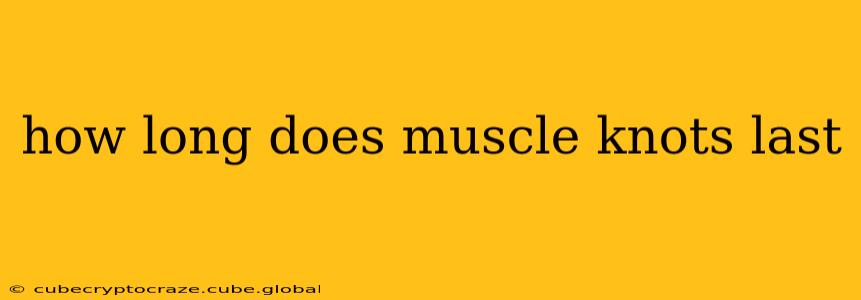Muscle knots, also known as myofascial trigger points, are tight bands of muscle fiber that can cause pain, stiffness, and limited range of motion. While many people experience them occasionally, understanding how long they last and how to treat them is crucial for managing pain and preventing future occurrences. The duration of a muscle knot varies significantly depending on several factors.
What Causes Muscle Knots?
Before diving into the duration, let's briefly discuss the root causes. Muscle knots are often triggered by:
- Overuse: Repetitive movements or strenuous activity can overload muscles, leading to knot formation. Think of repetitive typing, heavy lifting, or prolonged periods of awkward posture.
- Injury: Muscle strains or sprains can create trigger points as the body attempts to heal the damaged tissue.
- Stress: Chronic stress can tense muscles, making them more susceptible to knot development.
- Poor Posture: Maintaining poor posture for extended periods puts unnecessary strain on certain muscle groups.
- Dehydration: Lack of sufficient hydration can impact muscle function and contribute to knot formation.
- Lack of Stretching: Insufficient stretching before and after physical activity can leave muscles tight and prone to knots.
How Long Do Muscle Knots Typically Last?
There's no single answer to how long a muscle knot will last. It depends on several factors:
- Severity: A minor knot might resolve within a few days with self-care measures. More severe knots, however, can persist for weeks or even months if left untreated.
- Underlying Cause: Addressing the root cause, whether it's overuse, injury, or poor posture, is crucial for effective treatment and reducing duration.
- Individual Factors: Factors like overall health, fitness level, and pain tolerance can influence the duration and intensity of the pain.
- Treatment: Prompt and appropriate treatment can significantly shorten the duration.
How Can I Tell if I Have a Muscle Knot?
Identifying a muscle knot involves recognizing several key symptoms:
- Localized Pain: A specific, often intense, point of pain within a muscle.
- Muscle Tightness: A palpable, taut band of muscle fiber.
- Referred Pain: Pain radiating from the knot to other areas of the body.
- Limited Range of Motion: Difficulty moving the affected muscle or joint.
What are the Treatment Options for Muscle Knots?
Several effective treatments can help resolve muscle knots and reduce pain:
- Self-Massage: Applying gentle pressure to the knot using your fingers, a tennis ball, or a foam roller can help release tension.
- Stretching: Regular stretching can improve flexibility and prevent future knot formation. Focus on stretches that target the affected muscle group.
- Heat and Cold Therapy: Applying heat or cold packs can help reduce pain and inflammation.
- Over-the-Counter Pain Relief: Non-steroidal anti-inflammatory drugs (NSAIDs) can help reduce pain and inflammation.
- Professional Help: If self-treatment isn't effective, consider consulting a physical therapist, chiropractor, or massage therapist for professional treatment. They can provide targeted therapies such as myofascial release or trigger point injection.
How Can I Prevent Muscle Knots?
Prevention is key! Incorporate these habits into your routine:
- Regular Stretching: Stretch regularly, especially after exercise or prolonged periods of sitting.
- Proper Posture: Maintain good posture while sitting, standing, and working.
- Hydration: Drink plenty of water throughout the day.
- Regular Exercise: Engage in regular physical activity to improve muscle strength and flexibility.
- Stress Management: Practice stress-reducing techniques like yoga, meditation, or deep breathing exercises.
Will a Muscle Knot Go Away on Its Own?
While some minor muscle knots might resolve on their own with rest and self-care, more severe knots often require intervention. Ignoring them can lead to chronic pain and functional limitations.
How Long Does It Take for a Muscle Knot to Heal After Massage?
The healing time after massage therapy varies depending on the severity of the knot and the individual's response to treatment. Some individuals experience immediate relief, while others may need multiple sessions to see significant improvement.
What Happens if Muscle Knots Are Left Untreated?
Leaving muscle knots untreated can lead to chronic pain, reduced range of motion, and potentially more significant health issues. It's crucial to address muscle knots promptly to prevent long-term complications.
This information is for general knowledge and does not constitute medical advice. Always consult a healthcare professional for diagnosis and treatment of any medical condition.
